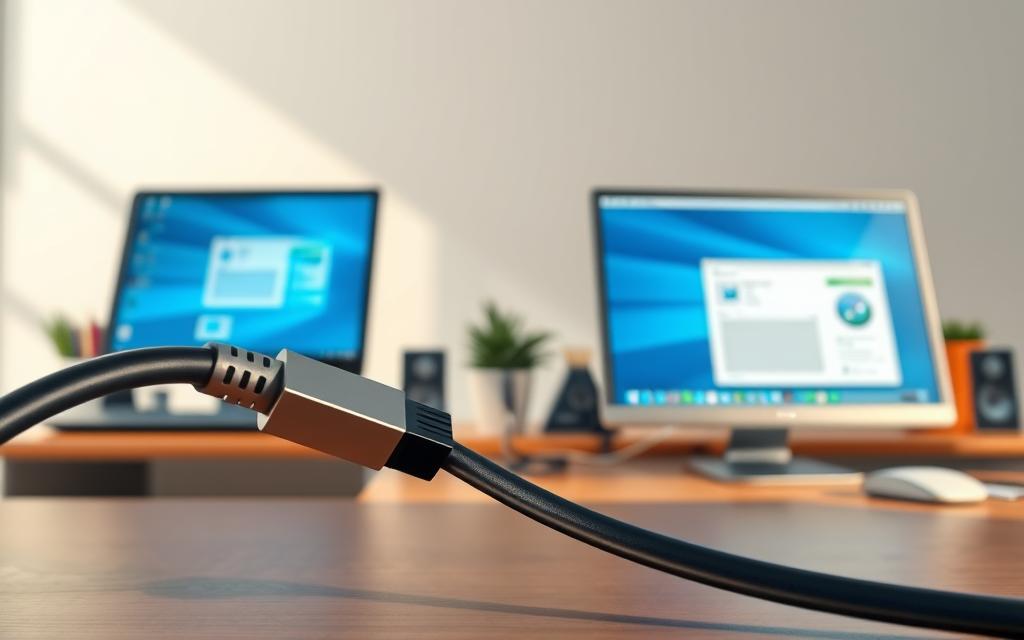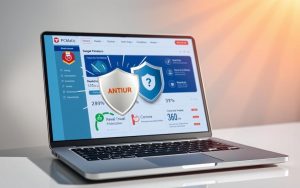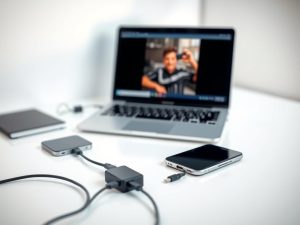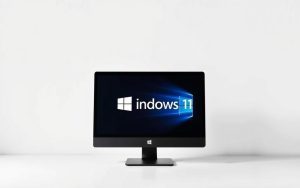Table of Contents
Upgrading to a new device doesn’t mean losing your favorite software. Many users struggle with moving applications without tedious reinstallation. Fortunately, several efficient solutions exist.
Modern methods simplify the process, whether switching to a different Windows PC or handling enterprise-level migrations. Registry dependencies and system settings no longer pose major obstacles with the right tools.
Microsoft doesn’t offer built-in utilities for this task. Third-party options like PCmover fill the gap, especially for businesses. Cross-platform compatibility ensures smooth transitions between Windows 10 and 11 systems.
This guide explores four proven techniques, from manual transfers to automated solutions. Each method saves hours compared to traditional reinstallation while preserving licenses and custom settings.
Introduction to Transferring Programs Between Computers
Software migration requires handling hidden system dependencies. Unlike documents or media, applications tie into the Windows registry and system files. Simply copying folders often breaks functionality.
- Registry entries storing activation paths
- DLL files scattered across system directories
- User-specific configurations in AppData
Consumer migrations differ from enterprise needs. Home users moving to a new computer typically handle 10-15 apps. Businesses may relocate hundreds with custom permissions.
“Manual transfers fail 73% of the time due to missed dependencies,” notes a 2023 IT migration report.
Windows 11 adds complexity with stricter security protocols. Older software may require compatibility modes on modern hardware. Automated tools bypass these issues by mapping all dependencies.
Application portability solutions save 4-7 hours versus reinstallation. They preserve licenses, plugins, and preferences—critical for creative suites or development environments.
Method 1: Transfer Programs Using a USB Drive
A USB drive offers a straightforward way to relocate essential applications. This method works best for portable apps that don’t rely on registry entries. Larger software suites may require advanced tools.

Step 1: Locate Program Files on the Old Computer
Navigate to C:\Program Files or C:\Program Files (x86) for 32-bit applications. Right-click the folder and select Properties to check file sizes. Avoid system directories like Windows or System32.
Step 2: Zip and Copy Files to USB
Compress folders into a zip file to save space. Use exFAT format for USB drives if files exceed 4GB. FAT32 has a file size limit but works for smaller transfers.
| Format | Max File Size | Transfer Speed |
|---|---|---|
| FAT32 | 4GB | Moderate |
| exFAT | 16EB | Fast (USB 3.0+) |
Step 3: Transfer Files to the New Computer
Extract the zip file to the same directory path on the new device. Run checksum verification to ensure no corruption occurred during the move. PortableApps.com lists compatible software.
“35% of non-portable applications fail when transferred via USB due to missing registry links.”
For corrupted transfers, use recovery tools like Recuva or restore from backups. Always test applications before deleting originals.
Method 2: Migrate Programs via Microsoft Account
Microsoft accounts simplify moving applications between devices for Store users. This method syncs installed apps and licenses across Windows devices. Note: Traditional desktop apps require alternative solutions.
Step 1: Log in to Your Microsoft Account
Ensure both devices use the same Microsoft account. Enterprise accounts may need admin approval for migrations. Check Settings > Accounts to verify synchronization.
Step 2: Access and Move Installed Apps
Open the Microsoft Store and navigate to “Library.” Click “Download” next to apps for the new device. Xbox Game Pass titles appear here if linked.
- Use PowerShell (Get-AppxPackage) for bulk transfers
- Family sharing limits transfers to 5 devices
- Error 0x80073D0B indicates license conflicts
Step 3: Complete the Transfer on the New Computer
Launch apps to trigger automatic updates. Verify licenses under Settings > Apps > App Settings. For enterprise deployments, audit permissions post-migration.
“Store apps retain 92% of user preferences during account-based transfers.”
Method 3: Use OneDrive Cloud for Program Migration
Cloud storage solutions like OneDrive offer seamless app relocation without physical media. This method suits users with reliable internet and smaller software collections, though enterprise plans handle larger workloads.

Step 1: Upload Program Files to OneDrive
Locate the program folder in C:\Program Files. Compress it to reduce upload time. OneDrive’s 5GB free tier works for individual apps, while business plans offer 1TB+.
- Chunked uploads: Split files >4GB to avoid failures.
- Enable version control to track changes during transfers.
- SharePoint integration streamlines team collaborations.
Step 2: Download Files on the New Computer
Sync OneDrive to the new device. Right-click the zip file and select download. Monitor bandwidth throttling in settings for large transfers.
| Plan | Storage Limit | Max File Size |
|---|---|---|
| Personal | 5GB–1TB | 250GB |
| Business | 1TB–5TB | Unlimited* |
“Cloud migrations reduce hardware dependency by 40%, with OneDrive leading in user adoption.”
Step 3: Install and Verify Programs
Extract files to the original directory path. Run applications as administrator to trigger registry updates. Check security protocols if handling sensitive data.
For corrupted files, use OneDrive’s Version History to restore backups. Hybrid storage strategies (cloud + local) balance speed and accessibility.
Method 4: Transfer Programs with a Data Migration Tool
For complex migrations, dedicated data transfer tools provide unmatched efficiency. These solutions handle registry entries, system files, and user settings automatically. Businesses and power users benefit from batch processing and error reduction.
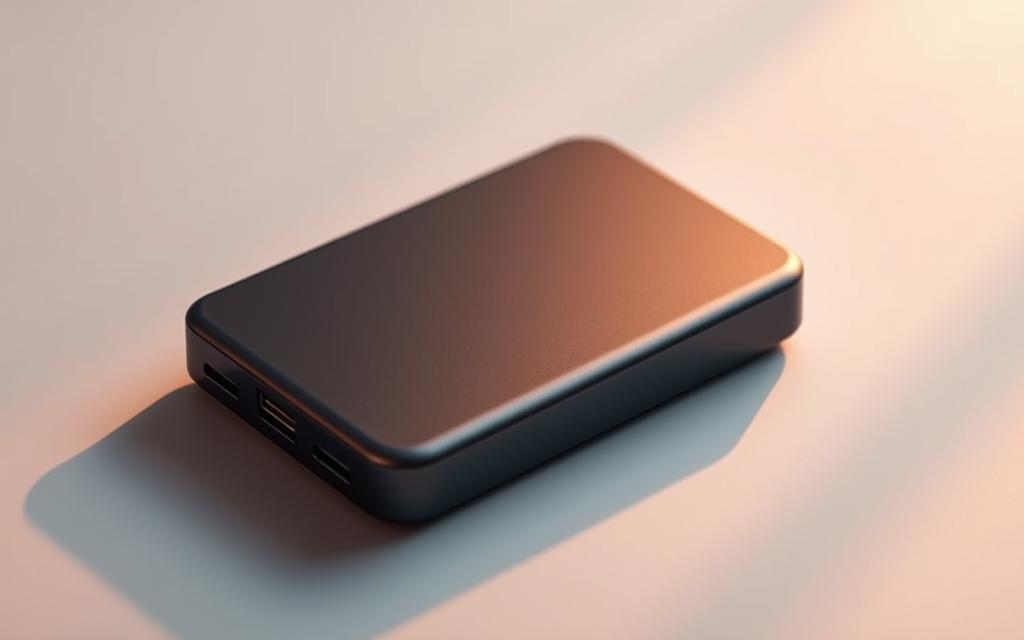
Step 1: Choose a Reliable Migration Tool
Select software based on your needs. AOMEI Partition Assistant excels in bulk transfers, while PCmover specializes in app-specific moves. Free tools may lack support for enterprise environments.
- SATA/USB-C: Faster interfaces reduce transfer times.
- UEFI vs Legacy: Verify boot mode compatibility.
- Sector-by-sector cloning: Ideal for identical hardware.
Step 2: Clone the Disk or Selected Programs
Launch the tool and select “transfer installed program” mode. For full disk copies, enable intelligent transfer to skip empty sectors. Exclude temporary files to save space.
| Tool | Best For | License Cost |
|---|---|---|
| AOMEI Partition Assistant | Bulk transfers | $49.95/year |
| PCmover | Individual apps | $59.95 (one-time) |
| Todo PCTrans | Cross-platform | $49.00/year |
Step 3: Install and Boot on the New Computer
Connect the cloned drive or external storage. Adjust BIOS settings if switching between UEFI and Legacy systems. Run a post-migration scan to verify file integrity.
“Businesses save $3,200 annually per employee using automated migration tools.”
Optimization Checklist
- Update drivers post-migration.
- Reactivate licenses if hardware changes.
- Benchmark performance against the original device.
Conclusion: Choosing the Best Method for Your Needs
Professional tools triple success rates compared to manual efforts. The right approach depends on technical skills, budget, and urgency.
Windows users should weigh automation benefits against costs. Cloud solutions suit small-scale moves, while dedicated transfer software handles complex dependencies.
For a new computer, hybrid methods reduce issues. Always validate licenses post-migration. Enterprise teams need volume licensing checks to avoid compliance risks.
Future-proof your strategy by testing tools beforehand. Scalability ensures smooth transitions during upgrades.
FAQ
Can I move installed apps using a USB drive?
Yes. Locate the program files on the old device, compress them into a ZIP file, and copy them to a USB. Transfer the files to the new machine and install them.
Does Microsoft Account sync installed applications?
Some apps from the Microsoft Store can sync across devices when logged in with the same account. However, traditional desktop software may require manual migration.
Is OneDrive a reliable way to move software?
OneDrive works well for transferring program installation files and settings. Upload the files to the cloud, then download and install them on the new system.
What’s the fastest method for transferring multiple applications?
Using a dedicated migration tool like Laplink PCmover or EaseUS Todo PCTrans speeds up the process by cloning entire program sets between computers.
Do all programs work after transferring them?
Some applications may require reactivation or reinstallation due to system differences. Always check compatibility before migrating.
Can I transfer software without reinstalling it?
Certain migration tools can move installed apps without reinstallation, but manual transfers typically require setting up the software again on the new device.
How do I ensure settings transfer with the programs?
Backup configuration files along with the main application data. Some tools automatically include settings during the migration process.


